The History Of Cadillac Eldorado

The Eldorado model was part of the Cadillac line from 1953 to 2002. The Cadillac Eldorado was the longest running American personal luxury car as it was the only one sold after the 1998 model year. Its main competitors included the Lincoln Mark Series and the lower-priced Buick Riviera.
Although cars bearing the name varied considerably in bodystyle and mechanical layout during this long period, the Eldorado models were always near the top of the Cadillac line. Nevertheless, and except for the Eldorado Brougham models of 1957–1960, the most expensive models were always the opulent, long wheel-based Series 75 sedans and limousines, not the Eldorado.
The name was proposed for a special show car built in 1952 to mark Cadillac's Golden Anniversary; it was the result of an in-house competition won by Mary-Ann Zukosky (married name = Marini), a secretary in the company's merchandising department. Another source, Palm Springs Life magazine, attributes the name to a resort destination in California's Coachella Valley that was a favorite of General Motors executives, the Eldorado Country Club. In any case, the name was adopted by the company for a new, limited-edition convertible that was added to the line in 1953.
The name Eldorado was derived from the Spanish words "el dorado", "the gilded one" or "the golden one"; the name was given originally to the legendary chief or "cacique" of a South American Indian tribe. Legend has it that his followers would sprinkle his body with gold dust on ceremonial occasions and he would wash it off again by diving into a lake. The name more frequently refers to a legendary city of fabulous riches, somewhere in South America, that inspired many European expeditions, including one to the Orinoco by England's Sir Walter Raleigh.
The 1953 Eldorado was a special-bodied, low-production convertible (532 units in total). It was the production version of the 1952 El Dorado "Golden Anniversary" concept car. Available in four unique colors (Aztec Red, Alpine White, Azure Blue and Artisan Ochre — the latter is a yellow hue, although it was shown erroneously as black in the color folder issued on this rare model). Convertible tops were available in either black or white Orlon. There was no special badging on the car, other than the "Eldorado" nameplate, in "gold", in the center of the dash. A hard tonneau cover, flush with the rear deck, hid the top in the open car version. Although it was based on the regular Series 62 convertible and shared its engine, it was nearly twice as expensive at US$7,750. This car was 221inches (5,600mm) long and 79inches (2,000mm) wide.
This first Eldorado had a wraparound windshield and a cut-down beltline, the latter signifying a dip in the sheetmetal at the bottom of the side windows. These two touches were especially beloved by General Motors Styling Chief Harley Earl and subsequently were widely copied by other marques. In fact, throughout 1950s, Eldorado was General Motors' styling leader, and since GM led the industry, where the Eldorado went, everyone else would tend to follow.
In 1954, Eldorado lost its unique sheet metal, sharing its basic body shell with standard Cadillacs. Distinguished now mainly by trim pieces, this allowed GM to lower the price and they were rewarded with a substantial jump in sales.
For 1955, the Eldorado's body gained its own rear end styling with high, slender, pointed tailfins. These contrasted with the rather thick, bulbous fins which were common at the time and were an example of Eldorado once again pointing the way forward.
For 1956, a two-door hardtop coupe version appeared, called the Eldorado Seville.
1957
1957 saw the Eldorado (in both Biarritz convertible and Seville hardtop bodystyles) with a revised rear-end design featuring a low, downswept fenderline capped by a pointed, in-board fin. The rear fenders were commonly referred to as "chipmunk cheeks". This concept was used for two years, but did not spawn any imitators.
1957 was chiefly notable, for the introduction of one of GM's most memorable designs, the Eldorado Brougham. This four-door hardtop with rear-hinged rear doors was an ultra-luxury car that cost an astonishing $13,074 — more than the Rolls-Royce Silver Cloud of the same year. It featured a stainless steel roof, air suspension, the first memory power seats, and every other comfort and convenience feature available at GM at the time.
A different Eldorado Brougham was sold for 1959 and 1960. These cars were not quite so extravagantly styled but were very unusual pieces in themselves. Priced at $13,075, they cost $1 more, each, than their older siblings. The design was 100% Cadillac but the company contracted out the assembly to Pininfarina of Italy, with whom the division has had a long-running relationship, and these Eldorados were essentially hand-built in Italy. Discreet, narrow taillights - were integrated into modest tailfins, and a squared-off rear roof line allowed the Brougham to contrast sharply to the "rocketship" taillights, flamboyant fins, and rounded roof lines of the standard 1959 Cadillacs. However, the Brougham's styling cues would prove to indicate where Cadillac styling would head in the early-mid 1960s. Build quality was not nearly to the standard of the Detroit hand-built 1957–1958 models, and the 1959–1960 Broughams did not sell as well as their forebears. However, collector interest and values remain high.
The last Eldorado Seville was built in 1960. After that, the Eldorado convertible became essentially a more luxuriously trimmed version of the Cadillac Series 62 convertible (using trim pieces reserved only for the Fleetwood Sixty Special).
An Eldorado convertible would remain in the Cadillac line through 1966, but its differences from the rest of the line were generally modest. In 1964, probably the most distinctive year during this period, the main visual cue indicating an Eldorado was simply the lack of fender skirts.
The Eldorado was radically redesigned for 1967. Intended for the burgeoning personal luxury car market, it was a "personal" Cadillac sharing the E-body with the Oldsmobile Toronado that had been introduced the previous year. Cadillac adopted the Toronado's unique Unified Powerplant Package and front-wheel drive. The Eldorado used a standard Cadillac 429 V8 with a modified Turbo-Hydramatic automatic transmission (THM425, based on the Turbo-Hydramatic 400) with the torque converter mounted next to the planetary gearbox, driving it through a metal chain.
Despite sharing a body shell with the Toronado, the Eldorado's crisp styling, initiated by GM styling chief Bill Mitchell, was distinctive and unique, with hidden headlights and a long-hood, short-deck look. Performance was 0–60 mph (0–96 km/ h) in less than nine seconds and a top speed of 120 mph (192 km/ h). Roadability and handling were highly praised by contemporary reviews. Disc brakes were optional in 1967 and standard starting in 1968. Sales were excellent despite high list prices.
For 1968 the Eldorado gained slight exterior changes to comply with new federal safety and emissions legislation, and as with the rest of the Cadillac lineup, a new 472 cu in (7.7 L) V8 engine rated at 375hp (280kW) (SAE gross). In 1969 it lost its hidden headlamps and picked up as options a halo vinyl roof and later in the model year a power sunroof option. For the 1970 model year, this body style Eldorado introduced the new 500 in³ (8.2L) V8 engine, the largest-ever production V8 [rated SAE gross 400hp (298kW) / 550ft·lbf (746N·m) in 1970] that would be an Eldorado exclusive until it became standard on all full size Caddies for model year 1975.
When GM's full-size cars were redesigned for 1971, the Eldorado regained both a convertible model and its fender skirts. The 126.3-inch (3,210mm) wheelbase version of the Eldorado would run through 1978, receiving facelifts in 1973 and 1975.
The Cadillac Eldorado was chosen as the pace car for the Indianapolis 500 Mile Race in 1973. All in all, Cadillac produced 566 of these special pace car convertibles. 33 were used at the track during the race week and the remaining 513 cars were distributed to the U.S. Cadillac dealers (one for each dealership), which were then sold to the general public.
A redesigned instrument cluster was phased in during the 1974 model year (known as the 'space age' instrument panel from Cadillac literature), also shared with Calais, DeVilles and Fleetwoods.
For 1977, the Eldorado received a new grille with a finer crosshatch pattern. The convertible was canceled (although Custom Coach of Lima, Ohio took a few brand-new 1977 and 1978 Eldorados into their coachbuilder facilities and converted into convertibles using salvaged parts from 1971-76 Eldorados; Cadillac did not produce convertibles after 1976). The 8.2L V8 of 1970-76 gave way to a new 7L V8 with 180bhp (134kW). Minor changes followed in 1978.
This generation of Eldorados produced between 1971 and 1978 were sometimes customized (as stereotyped "pimpmobiles") (bro cars) and seen in blaxploitation films like Dolemite, Superfly, The Mack, Willie Dynamite, (the pimped-out Eldorado seen in Willie Dynamite is similar to the one seen in Magnum Force),while the car used in the James Bond film Live and Let Die only looked like an Eldorado. In fact it was a Chevrolet Corvette equipped with some parts to make it look somewhat like a Cadillac. Just the front fenders were actual Eldorado body parts. It was called the Corvorado, made by Les Dunham. Dunham made just 7 Corvorados in total. An Eldorado was also used in Rob Zombie's second film, The Devil's Rejects as the car that the character Charlie, also a pimp, drove. Customizers such as Les Dunham Coachworks have modified brand-new Eldorados with headlight covers (commonly known as Superfly headlights), grille caps, a 1941 goddess hood ornament, lake pipes, and thick-padded vinyl tops, usually with circular porthole windows.
Eldorado Convertible for 1976
In 1976, when all other domestic convertibles had vanished, GM heavily promoted the American industry's only remaining convertible as "the last American convertible". 14,000 would be sold, many purchased as investments. The final 200 convertibles produced were designated as "Bicentennial Edition" commemorating America's 200th birthday. These cars were white with a dual-color red/ blue pinstripe along the upper bodyside. The seats were piped with red leather, and a commemorative plaque was fastened to the dashboard. In 1983, when GM reintroduced convertibles, 1976 Eldorado owners, who felt they had been deceived, launched an unsuccessful class action lawsuit.
Eldorado Biarritz
Unlike the Fleetwood and de Ville models, Eldorado didn't have a unique luxury package to provide it with a title change (such as the "d'Elegance" package). This was rectified in 1977 with the "Biarritz" package. Trim differences on the 1977 and 1978 models included stainless steel trim on the hood, doors and rear fenders. The rear half of the roof was covered with a heavily padded landau vinyl top accented with "opera" lights. Biarritz script adorned the trunk lid, landau roof and glove box door. The interior featured "pillowed"-style velour or leather seating. Starting in 1979, the roof was capped with stainless steel, reminiscent of the ultra-luxury 1957 and 1958 Eldorado Brougham. The Biarritz option stayed with the Eldorado through the 1991 model year. Some of the original styling cues vanished after the 1985 model year, such as the brushed aluminum roofing and the interior seating designs, but "Biarritz" remained unique just the same.
For 1979, a new, trimmer Eldorado was introduced, and for the first time the car shared its chassis with the Buick Riviera as well as the Toronado. Smaller 350 and 368 in³ (5.7 and 6.0 L) V8's replaced the 500 and 425 in³ (8.2 and 7.0 L) of the preceding model, giving better fuel efficiency. For 1979, it was offered only with the Oldsmobile 350 as standard, then in 1980 this was replaced with the Cadillac 368 (see below for this engine's origins). For California only, the Olds 350 was retained for 1980. In both the 1980 Seville and Eldorado (which shared their frames), the 368s in 1980 came with DEFI, whereas for the larger RWD Cadillacs, the 368 only came with a 4-barrel Quadrjet carburetor. Independent rear suspension was adopted, helping retain rear-seat and trunk room in the smaller body. The most notable styling touch was an extreme notchback roofline, making the rear window almost vertical. The Eldorado Biarritz model resurrected the stainless-steel roof concept from the first Brougham. Although downsized, these Eldorados were still substantial-sized cars with good room and power.
In 1984, Cadillac also introduced a convertible version of Eldorado Biarritz. It was 200 pounds (91kg) heavier, but featured the same interior as other Biarritz versions. The model year of 1985 was the last year for the AMC, Inc. aftermarket conversion Eldorado convertible was ever produced. Because of its limited edition (around 3000 total), the convertible models are now highly sought after by numerous collectors.
Prior to the 'official' 1984 and 1985 Eldorado convertibles marketed by Cadillac, some 1979-83 Eldorados were made into convertibles by independent coachbuilders e.g. American Sunroof Corporation, Custom Coach (Lima, Ohio), Hess & Eisenhardt. The same coachbuilders also converted the Oldsmobile Toronado into a ragtop.
Of all Eldorados, this generation can claim to be the best suited to the market and the times.
Powertrain Selection
Cadillac offered three engines in 1981. The first was the V8-6-4 variable displacement engine, which was designed to deactivate some cylinders when full power was not needed, helping meet GM's obligations under the government fuel economy ("CAFE") standards. It was a reduced bore version of the 1968 model-year 472, sharing that engine's stroke and also that of the model-year 1977–1979 425. The engine itself was extremely rugged and durable, but its complex electronics were the source of customer complaints. (note: the new small 1979 Eldorado did not use the 425, only the Oldsmobile-sourced 350).
The 1981 model year has been cited been as having an unexplained balancing problem that affected the vehicle's overall handling[citation needed]. GM is said to have corrected this by installing a large, heavy metal plate under the driver's seat[citation needed]. This was used as a plot device in the 1995 movie Casino, where Robert DeNiro's character survives a bomb planted under the driver's seat of his Cadillac Eldorado, and the plate is credited with saving his life after the explosion. This was based on an actual incident that happened to Frank Rosenthal, upon whose life story the film was based.
Another engine option was the 350in³ (5.7L) Oldsmobile Diesel V8, first offered in 1979. Designed as a specific block, rather than a sleeved gasoline conversion, the engine was plagued with problems: drivers were unfamiliar with diesel vehicles (e.g. not waiting for glow plug warmup), and the head bolts were inadequate for the 22:1 compression design, leading to head gasket failures. Subsequent revisions to the block and heads improved reliability, and the engine was de-rated from 120hp (89kW) to 105hp (78kW) by 1981. The history of failures resulted in dealer-provided gasoline-conversions of those vehicles, and the option was dropped by 1985.
The third engine, the HT-4100 was an in-house design that mated cast-iron heads to an aluminum block. Designed for a new generation of front-wheel drive vehicles, it was inadequate for a full-sized Cadillac, which weighed over 4000 pounds. HT-4100s failed in large numbers; thousands were replaced under warranty.[citation needed]
Nevertheless, the Eldorado's sales rose to unprecedented heights, nearly 100,000 units by 1984.
For 1986, another downsizing occurred. The costly Eldorado was now the same size that GM's own compact cars had been only a few years earlier, and much smaller than Lincoln's competing Mark VII. For the first time the Eldorado abandoned its hardtop heritage and had sedan frames around its windows. News reports later indicated that GM had been led astray by a consultant's prediction[citation needed] that gasoline would be at $3 per US gallon in the U.S. by 1986 and that very small luxury cars would be in demand. In fact, gasoline prices were less than half that. Sales were only about a fifth of what they had been two years earlier. This Eldorado received a facelift for the 1988 model and a slight sales recovery and continued on through 1991.
For 1992, a new Eldorado appeared. It was slightly bigger than its predecessor. Window glass was once again frameless, and shortly after introduction Cadillac's new Northstar V8 became available in both 270 and 295hp variants, replacing the 200hp 4.9L. Sales were up, though never again at record heights. The Eldorado's very similar four-door relative, the Cadillac Seville, consistently outsold it.
The Eldorado continued for the rest of the decade with incremental changes and tapering sales. In the wake of declining sales, circulating reports that the Eldorado would get a redesign for 1999 — similar to that which its Seville platform mate underwent for 1998 — would prove false as the car soldiered on largely unchanged into the new millennium.
Having lost its only remaining 2-door platform mate, the Buick Riviera, after the 1999 model year, rumors of the Eldorado's imminent demise began to circulate. GM showed a lowered, customized Eldorado-based concept at the 2000 North American International Auto Show, which was called EldoRODo, to little media or public interest.
Not long after, GM announced that the Eldorado's 50th model year, 2002, would be its last. To mark the end of the historic name, a limited production run 1,596 of cars in red or white - the colors available on the original 1953 convertible - were produced in three batches of 532, signifying the Eldorado's first year of production. The last cars had exhausts that were specially tuned to imitate the note of their illustrious forerunners from a half-century earlier and dash-mounted plaques indicating each car's sequence in production. Production ended on April 22, 2002 retooling the Lansing Craft Centre to build the Chevrolet SSR.
From Wikipedia, the free encyclopedia
More About Cadillac Eldorado
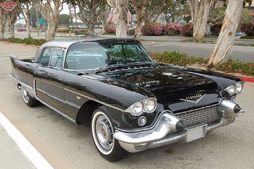
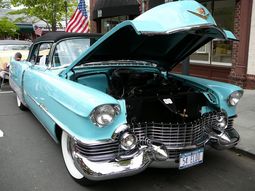
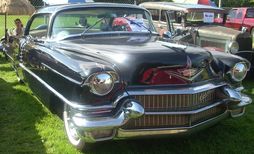
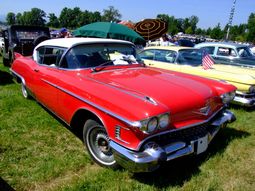
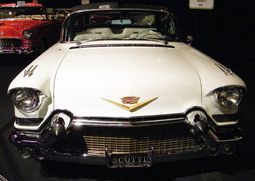
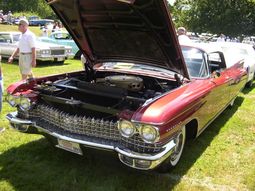
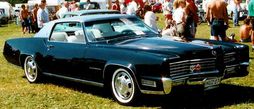
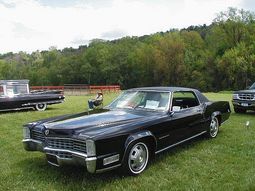
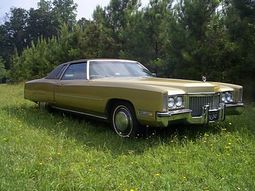
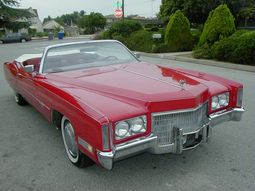
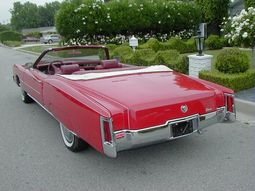
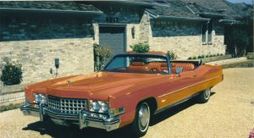
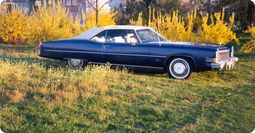
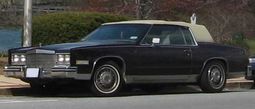
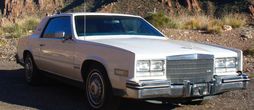
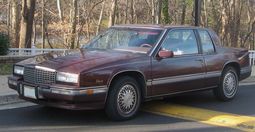

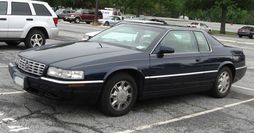
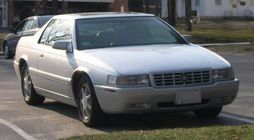
|